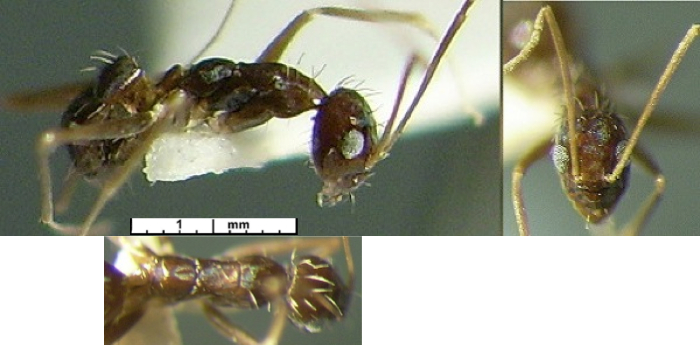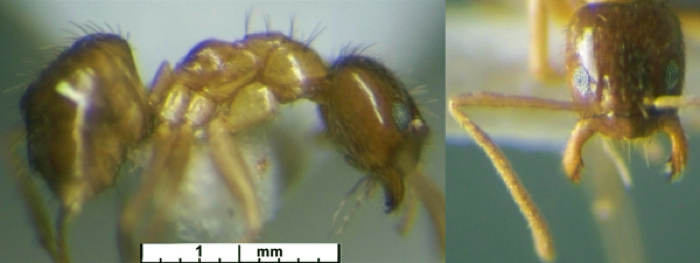SUBFAMILY FORMICINAE - Genus Paratrechina Motschulsky
| The Ants
of Egypt SUBFAMILY FORMICINAE - Genus Paratrechina Motschulsky |
In Tribe LASIINI, previously PRENOLEPIDINI.
Diagnostic Features - Dorsal surface of head, alitrunk and gaster with distinctly paired coarse hairs. Eyes well developed and set at or in front of the mid-length of the head. No ocelli. Antennae 12-segmented and inserted close to the posterior margin of the clypeus. Anterior clypeal margin entire or weakly emarginate medially. Mandibles narrow, with five or six teeth. Palpi long. Propodeum unarmed. Petiole a reduced scale inclined forwards and often overhung by the first gastral segment, always unarmed above. Acidopore borne on a conical projection of the hypopigium, and surrounded by a fringe of hairs.
Bernard (1952) writing of the Tribe LASIINI, described these as small, very specialised, terricolous ants, showing polymorphism. The larvae have a reduced buccal apparatus and are fed on alimentary fluids, notably the exudate of Homoptera, which the ant workers often raise in the nest. Most have a vast geographic distribution.
Motschoulsky's (1863) genus definition is at  .
.
See key by Emery (1910a: 127) at ![]() (P. flavipes is from Japan).
(P. flavipes is from Japan).
Note: La Polla, Brady & Shattuck (2010a) wrote a quite
dramatic revision, with good evidence from molecular phylogeny.
LaPolla, J.S., Brady, S.G., & Shattuck, S.O. 2010a. Phylogeny and
taxonomy of the Prenolepis
genus-group of ants (Hymenoptera:
Formicidae). Systematic Entomology,
35, 118-131.
In their Taxonomic History, they state - "Motschoulsky (1863) described
Paratrechina based on Pa. currens (which is now a synonym
of Pa.
longicornis Latreille, 1802) but the genus received little
attention
and was synonymized with Prenolepis
by von Dalla Torre (1893). Emery
(1925) removed Paratrechina
from synonymy with Prenolepis
as part of
his world species catalogue, and it was at this time that many species
were transferred to Paratrechina
from Prenolepis". From that,
as
"Paratrechina longicornis"
represents a distinct lineage and is the
type species, Paratrechina is
redefined as a monotypic genus.
Looking in great depth at all the available evidence, I (BT) concluded their assessment was fundamentally flawed. Of primary importance is the actual Motschoulsky description (see link above). The species described fully, with an illustration, is Paratrechina vagabunda. If anything, it is longicornis that is the aberrant form. So, I have retained the following species as Paratrechina. On, for example, Antweb, many species are listed as in the genus Nylanderia.
For more on this, see http://antsofafrica.org/ant_species_2012/paratrechina/paratrechina/paratrechina.htm.
I have been told on good authority that the type specimens of P. vagabunda survived in Moscow and were lent some four years ago to Dr LaPolla. Conicidentally, I had been sent ants from a location in Sri Lanka (Ceylon) close to where the types were collected and felt that among them were specimens that matched Motschoulsky's P. Vagabunda - see http://antsofafrica.org/ant_species_2012/paratrechina/paratrechina_vagabunda/paratechina_vagabunda.htm.
Separation of species known from Egypt
| 1 |  With elongated legs and
scapes, latter twice as long as head; TL 2.5-3.0 mm; body almost smooth
and very shiny; erect pilosity long and yellow; brown-black or
reddish-brown, often with a violet irridescence, appendages pale With elongated legs and
scapes, latter twice as long as head; TL 2.5-3.0 mm; body almost smooth
and very shiny; erect pilosity long and yellow; brown-black or
reddish-brown, often with a violet irridescence, appendages pale |
longicornis |
| -- | Without elongated legs and scapes | 2 |
| 2 |  With noticeable
pubescence on gaster and fine erect hairs; TL 2.2-2.6 mm; yellow-brown With noticeable
pubescence on gaster and fine erect hairs; TL 2.2-2.6 mm; yellow-brown |
jaegerskioeldi |
| -- |  With only sparse
pubescence on gaster and coarse erect hairs; TL 2.0-2.5 mm; overall
brown, dark on the head and gaster With only sparse
pubescence on gaster and coarse erect hairs; TL 2.0-2.5 mm; overall
brown, dark on the head and gaster |
vividula |
|
©2005, 2006, 2015, 2019 - Brian
Taylor CBiol FRSB FRES 11, Grazingfield, Wilford, Nottingham, NG11 7FN, U.K. |
href="paratrechina.htm"